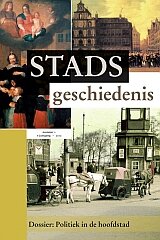Stadsgeschiedenis editie 2012 - 1
|
|
Hadewijch Masure Katrien Goossens en Maarten F. Van Dijck Annelies Jacobs (Dossier) Politiek in de hoofdstad (Review) Andreas Stynen en Bart Tritsmans (Review) Maarten F. Van Dijck |
Abstracts
Hadewijch Masure, Poor relief and community building in Brussels, 1300-1640
This article offers a multi-layered analysis of poor relief in Brussels between 1300 and 1640. What kind of community people had in mind when organizing poor relief: who got access to certain relief systems and who did not? I have made an overview of the diverse existing relief systems: hospitals, hospices, poor tables, confraternities, poor boxes etc. Then I focus on three specific aspects of community definition: membership requirements, regulations regarding origin and standards of behaviour. It appears that poor relief was made more rigid and exclusive earlier and originated more from ‘bottom up’ than often presumed, particularly in private systems. Also, the idea of a civic community was more and more taking hold, despite interferences with other communities.
Katrien Goossens and Maarten F. Van Dijck, Chambers of Rhetoric between old and new theater culture. The Antwerp Chamber of Rhetoric De Violieren and the rise of a commercial culture (1619-1762)
This article shows that the separation between late medieval corporative organizations and new seventeenth and eighteenth societies was less sharp as the existing literature claims. The Antwerp Chamber of rhetoric De Violieren evolved during the early modern period from a late medieval corporation to a voluntary association. Although city officials and administrators partially left the association, the Chamber still united the creative and intellectual elite of the city. De Violieren even managed to acquire an autonomous place in the ‘new’ commercial culture of the eighteenth century. The rhetoricians gained a central role in the urban culture by setting up public performances at a charge and they adapted thire plays to the preferences of the public through the provision of expensive showpiece events and the introduction of popular genres such as the opera. However, the Chamber remained an amateur group and in that sense the new genres eventually grew beyond their capability. This resulted in the closure of the Chamber in 1762.
Annelies Jacobs, War sound in the city and urban sound in wartime: sound and meaning
This article deals with the sound scape of Amsterdam during World War ii. It examines the sounds of war that residents of Amsterdam could hear, and the changing sounds of life in the city due to the interruption of former routines. It shows how the residents more or less adapted to the sounds of war and how familiar sounds took on entirely new meanings. As it turns out, experiences of war are not just related to ear deafening noise, but also include silence, music and daily sounds. The ensuing volatility of the meaning of sounds in times of crises like war once more makes clear that by solely listening to recordings we cannot understand what these sounds signified to people in the past.
Marc Brodie, Politics in the poor streets of the Imperical City. National issues and local networks in late-Victorian London
Local networks and personal relationships are vitally important in political cultures and electoral outcomes, even in cities where the largest ‘national’ issues may seem to be of the most significance. In the East End of London in the late nineteenth century, the influence of church visitors and similar Conservative-leaning personal contacts, particularly upon the better-off sections of the working class, helped to create a generally greater willingness of such voters to abstain from voting. This, as much as the often-claimed direct support of the London poor for imperialism and similar policies, led to the apparent success of the Conservatives in these areas. This article illustrates the importance of extremely local politics in the reception and electoral consequences of national debates.
Marnix Beyen, The political power of 'clientelism'. Interactions between citizens and mp's in Paris, 1893-1914
Personal interactions between citizens and their mp’s are often labeled as ‘clientelist’, and therefore discarded from the field of political history. Focusing on the concrete contacts of two mp’s (Marcel Sembat and Paul Painlevé) with their constituents in early twentieth century Paris, this contribution suggests that these interactions could also provoke genuinely political dynamics. The context of a modern capital appeared to be very appropriate for these dynamics to arise and develop, since it not only provided geographical proximity between the citizens, the deputies and the national institutions, but also facilitated the circulation of political knowledge. Because of these political dynamics, personal interactions had an impact both on the careers of the mp’s and on the evolution of the French welfare state.
Krijn Thijs, The strange world of West-Berlin. The symbolic capital and ‘the shame of Schöneberg’
This article explores the autonomous culture of West Berlin. It argues that the distance from West Germany to the little island of Berlin was considerable, not only topographically, but culturally and politically as well. During the Cold War, West Germany claimed Berlin to be the natural capital of the undivided German nation. From the 1970s onwards, however, a growing gap occurred between this official mission and the everyday life in the isolated half city, with its alternative scene and its many subcultures. The article exemplifies this tension by interpreting the events following the fall of the Wall in 1989 as a clash of cultures – not only between West and East, but also between Bonn and West Berlin
